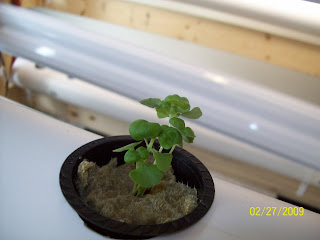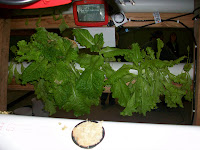 shed aside for a different unforeseen result. This entry will share those lost goals, valuable consequences, and some suggestions that will hopefully breed success for future similar undertakings.
shed aside for a different unforeseen result. This entry will share those lost goals, valuable consequences, and some suggestions that will hopefully breed success for future similar undertakings.
Originally, we had hoped to produce enough food on these systems to provide an economical and healthful subsidy to the diets of the residents of urban food deserts such as east Saginaw, which is laden with fast-food restaurants but lacks a supply of food as nature intended it. For this to work, the food produced would have had to been more valuable than the systems and the energy required to run them. The systems cost about $250 a piece, and the halogen lights added between $30 and 50$ to the power bill at each location. The nutrient solution required a bigger initial investment--about $100 for each of the 3 solutions--but would last probably over a year, so would amount to $10-25$ a month. So to be profitable--or worthwhile financially at all--each system would need to produce at least $40 of food each month, just to pay for the months costs, and hopefully a little more to eventually pay off that initial investment put into the systems. But, after 6 months of growing food, the 4 systems downtown produced less than 10 pounds total of lettuce, collards, kale, and parsley combined. Basil, spinach, and cilantro yielded less than one serving so will not be considered in the total. So if the monetary value of food were the only thing gained in this project, it would be a sore failure indeed, and the verdict would be to just go to Meijer to purchase groceries instead of spending a whole lot of time to produce food at around 50 times the cost of the grocery store produce.
But this is not the case. Much more was gained in the form of community awareness of food systems and food production. Networking was established between the various people and organizations with the resources to further develop a healthful, economically viable food production subsidy in Saginaw. There are prospects of constructing greenhouses on the horizon. One abandoned lot has been turned into an oasis of plants in the middle of a landscape of concrete and electrical wires. These developments are important and essential steps that much be taken before the eventual goal of widespread healthful diets and local food production can be accomplished. The pioneer who takes the first steps rarely takes the last ones. Building the community that will carry the torch is essential.
If this project or anything with similar goals is to be carried out again, there are a few areas which would be greatly improved upon. Everything could be done for much cheaper and some initial preparation would help to foster more productive plants. The systems used in this project were designed for greenhouses, but function inefficiently in a regular indoor setting. To spend so much money on boards and PVC pipe is unnecessary; the principles of hydroponics can be put into many different shapes to fit the room, just like a regular garden would be customized to fit one's yard. I encourage anyone looking to build their own hydroponics system to first decide where it will be put and then begin seeking the cheapest materials possible to construct a system to hold in water and support a plant in that area. Amazing things have been done in Rubbermaid containers. There is also no need to pay for electricity to pump water. Systems can be made to have only one level, and the fish bubblers used to oxygenate the water are very inexpensive--$6 or so with negligible energy costs. The second area for cost cutting is the lighting. It is important to acknowledge that there is no real substitute for natural sunlight, but the cl
 osest things cost hundreds of dollars. Without either of those, growing anything that requires fruiting or flowering is a futile effort. BUT, if you are growing just leafy greens, I recommend florescent lights. They produce much less heat, consume much less energy, have have shown no less capability of fostering plant growth than the very hot and costly halogen lights on the systems downtown. Additionally, they distribute the light more evenly than do the halogen lights, preventing the sporadic growth of steps on plants that should not have stems, like this 3-foot long lettuce plant pictured here. The initial cost of the florescent lights is more than the cost of the halogens, but the difference in the energy bill will compensate for that investment in 4 to 6 months.
osest things cost hundreds of dollars. Without either of those, growing anything that requires fruiting or flowering is a futile effort. BUT, if you are growing just leafy greens, I recommend florescent lights. They produce much less heat, consume much less energy, have have shown no less capability of fostering plant growth than the very hot and costly halogen lights on the systems downtown. Additionally, they distribute the light more evenly than do the halogen lights, preventing the sporadic growth of steps on plants that should not have stems, like this 3-foot long lettuce plant pictured here. The initial cost of the florescent lights is more than the cost of the halogens, but the difference in the energy bill will compensate for that investment in 4 to 6 months. 
To highlight the difference the presence of natural light makes to plant growth, I present the success of the basil plants at Living Center South. First is pictured the stringy, sickly looking basil plant grown in the basement of the Houghton-Jones Community Center without any natural light at all. Notice the very long stems and tiny little leaves. This is the sort of shape that is looked for in runway supermodels, but does not do much for growing tasty basil. At LCS, on the other hand, with only a westward-facing window, the plants have become much more robust, w
 ith giant healthy leaves. This is more of a Mrs. Butteworths
ith giant healthy leaves. This is more of a Mrs. Butteworths  shape, and is exactly the kind of dimensions looked for in a tasty basil plant since we are eating the leaves, not the stems.The same is true with the lettuce. Where there is sun, there is big healthy leaves and not vines; where there is no sun, there are oblong leaves and stems stretching towards the light source. If you doubt the deliciousness of this basil, observe the face of this jubilant civilian as he enjoys a plate of spaghetti tops with freshly brewed pesto made from the leaves of our very own basil. What could be a better testament to the value of homegrown greens than an exression of emotion such as this?
shape, and is exactly the kind of dimensions looked for in a tasty basil plant since we are eating the leaves, not the stems.The same is true with the lettuce. Where there is sun, there is big healthy leaves and not vines; where there is no sun, there are oblong leaves and stems stretching towards the light source. If you doubt the deliciousness of this basil, observe the face of this jubilant civilian as he enjoys a plate of spaghetti tops with freshly brewed pesto made from the leaves of our very own basil. What could be a better testament to the value of homegrown greens than an exression of emotion such as this?In 7 days, I depart for Guadalajara, Mexico to improve my Spanish skills while escaping the rational madness of American life. While there, I intend to seek out community agricultural groups to further develop my understanding of food systems and hopefully stumble across something that will be of value to another place I go in my short time here on Earth. Until next time, keep on fighting the good fight and eating the good food.
Adios, y Buenes Suerte,
Stu





















 harvested the lettuce was because I am not really sure how to harvest anything else, so I will be watching a series of you-tube "how-to" videos before harvest the kale, which is also quite large, along with the spinache.
harvested the lettuce was because I am not really sure how to harvest anything else, so I will be watching a series of you-tube "how-to" videos before harvest the kale, which is also quite large, along with the spinache. 






